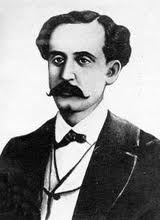Donato Mármol
Cuban revolutionary and army general (1843–1870) From Wikipedia, the free encyclopedia
Donato Mármol (February 14, 1843 – June 26, 1870) was a Cuban revolutionary and general who played a key role in the Ten Years' War in Cuba.
Donato Mármol | |
|---|---|
 | |
| Birth name | Donato Mármol y Tamayo |
| Born | February 14, 1843 Bayamo, Oriente Province, Captaincy General of Cuba, Spanish Empire |
| Died | June 26, 1870 (aged 27) Palma Soriano, Oriente Province, Captaincy General of Cuba, Spanish Empire |
| Allegiance | Cuba |
| Service | Cuban Liberation Army |
| Years of service | 1868–1870 |
| Rank | Major General |
| Battles / wars | |
Early life
Donato Benjamín del Mármol y Tamayo was born in Bayamo, Spanish Cuba on February 14, 1843.[1] His father, a Venezuelan native and captain in the Spanish Army, moved with his family to Santiago de Cuba, where Donato finished his education.[2]
Ten Years' War
Summarize
Perspective
Mármol was involved in early revolutionary meetings, including one led by Carlos Manuel de Céspedes in September 1868, where he acted as the leader of Jiguaní.[3]
Following Céspedes' Cry of Yara on October 10, 1868, Donato Mármol joined the war of independence against Spain. The revolutionary uprising spread rapidly throughout Eastern Cuba.
Acting as the associate leader under Calixto García, Mármol led 150 men from town to town on October 13, 1868, driving the insurrection.[4] They attacked the towns of Santa Rita and Baire, then seized Jiguaní, capturing the governor in the process.[5][6] By October 19, 1868, his forces captured Bayamo, which then became the location of the revolutionary government.[7] The Màrmol column seized weapons from the Spanish Troops in the Bayamo garrison.[8]
Battle of Pino de Baire
On October 25, 1868, he engaged in the Battle of Pino de Baire in Baire, Oriente Province. He commanded a force of mambises with Gen. Maximo Gomez as his second-in-command against the Spanish troops of Col. Demetrio Quirós Weyler who was sent to recapture Bayamo.[9] Quirós was eventually forced to retreat to Santiago de Cuba.[10]
Donato Mármol and Félix Figueredo attacked El Cobre in Santiago de Cuba in November 1868, though their effort failed. Shortly after, Gen. Mármol directed Figueredo to take control of the plaza, which had been deserted by the Spanish.[11]
Mármol's forces had been called from Santiago de Cuba to Bayamo in January 1869 to prevent Blas Villate, Count of Valmaseda's march on Bayamo.[12] The Cuban defeat at the Battle of El Salado led to the burning and abandonment of Bayamo by the Cubans.[13] Revolutionary discord peaked with Mármol's self-proclamation as Dictator, but Francisco Vicente Aguilera's intervention at a meeting in Tacajó on January 29, 1869, stabilized the movement.[14]
Upon Céspedes's presidency in April 1869, Mármol was assigned as a general in the Manuel de Quesada-led Cuban Liberation Army. Mármol led the 1st Brigade of Santiago de Cuba, part of the 2nd Division, Army of Oriente under Maj. Gen. Thomas Jordan.[15]
Death
Donato Mármol died from cerebral fever on June 26, 1870, in the Baraguá camp, and was buried at the San Felipe Estate near the Cauto River in Palma Soriano.[16][17]
Mármol's command in the Cuban Liberation Army was taken over by General Máximo Gómez.[18]
References
Wikiwand - on
Seamless Wikipedia browsing. On steroids.
